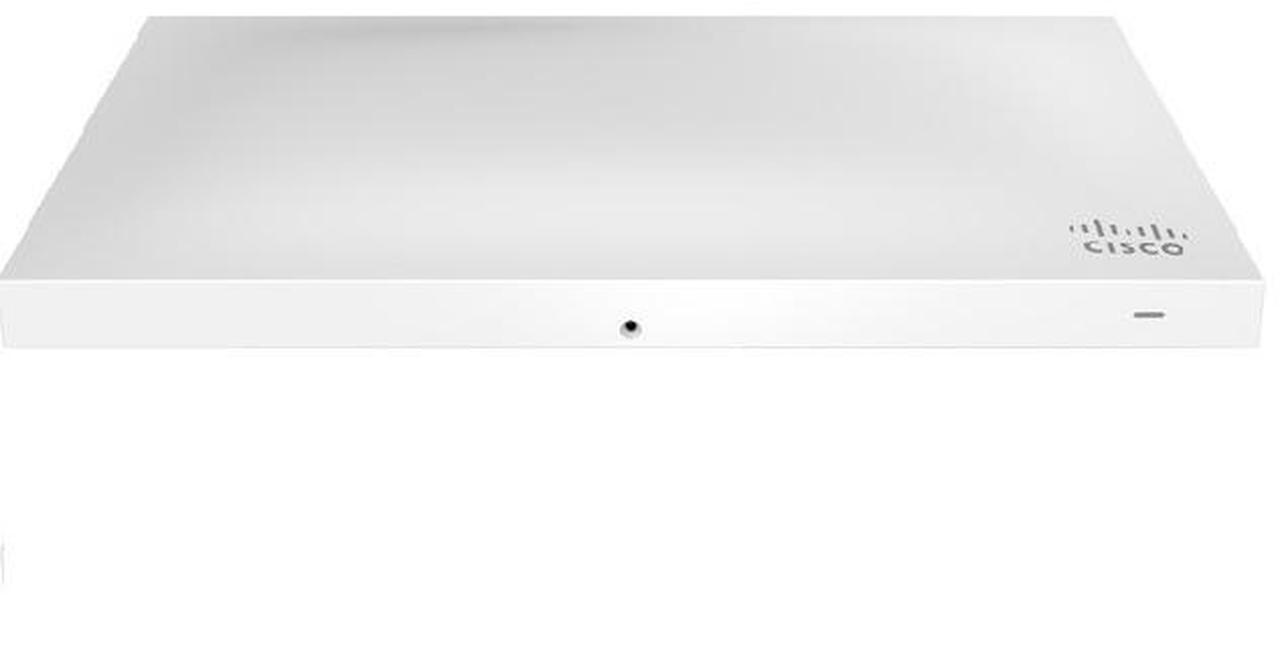
Cisco Meraki MR52
Dual-band enterprise-class 802.11ac Wave 2 access point
The MR52 is an enterprise-grade cloud-managed WLAN access point, ideal for performance-critical wireless LANs and high-density environments such as schools, offices and hotels. It uses advanced 802.11ac and 802.11n technologies including MIMO, beam forming and channel bonding to deliver the throughput and reliable coverage required by demanding business applications. In addition to 2.4 GHz and 5 GHz radios, a dedicated third radio provides real-time WIDS/WIPS with automated RF optimization, and a fourth integrated radio delivers Bluetooth Low Energy (BLE) scanning and Beaconing.
Management of the MR52 is through the Meraki cloud, with an intuitive browser-based interface that enables rapid deployment without time-consuming training or costly certifications. And with self-configuring, 24x7 monitoring, remote diagnostic tools and automatic firmware update, the MR52 can be easily managed, maintained and troubleshooted when deployed at a remote locations, even without on-site IT staffs.
The MR52 features two Gigabit Ethernet ports.
A 5 GHz 4x4:4 radio supporting 160 MHz channel widths and a 2.4 GHz 4x4:4 radio supporting 40 MHz channel widths offer a combined dual–radio aggregate frame rate of 2.5 Gbps*, with up to 1,733 Mbps in the 5 GHz band thanks to 802.11ac Wave 2 and 800 Mbps in the 2.4 GHz band. Technologies like transmit beamforming and enhanced receive sensitivity allow the MR52 to support a higher client density than typical enterprise-class access points, resulting in fewer APs for a given deployment.
* Refers to maximum over-the-air data frame rate capability of the radio chipset, and may exceed data rates allowed by IEEE 802.11ac-compliant operation.
With support for the 802.11ac Wave 2 standard, the MR52 offers MU-MIMO for more efficient transmission to multiple clients. Especially suited for environments with numerous mobile devices, MU-MIMO enables multiple clients to receive data simultaneously. This increases the total network performance and improves the end user experience.
The two Ethernet uplinks on the MR52 can be configured for link aggregation, which relieve any existing uplink bottlenecks created by 802.11ac Wave 2.
An integrated fourth radio for Bluetooth Low Energy (BLE) provides seamless deployment of BLE Beacon functionality and effortless visibility of BLE devices. The MR52 enables the next generation of location-aware applications while futureproofing your deployment, ensuring it’s ready for any new customer engagement strategies.
The MR52’s sophisticated and automated RF optimization means that there is no need for the dedicated hardware and RF expertise typically required to tune a wireless network. The RF data collected by the dedicated third radio is continuously fed back to the Meraki cloud. This data is then used to automatically tune the channel selection, transmit power, and client connection settings for optimal performance under even the most challenging RF conditions.
The MR52 features integrated, easy-to-use security technologies to provide secure connectivity for employees and guests alike. Advanced security features such as AES hardware-based encryption and WPA2-Enterprise authentication with 802.1X and Active Directory integration provide wire-like security while still being easy to configure. One-click guest isolation provides secure, Internet-only access for visitors. PCI compliance reports check network settings against PCI requirements to simplify secure retail deployments.
The MR52’s dedicated dual-band scanning and security radio continually assesses the environment, characterizing RF interference and containing wireless threats like rogue access points. There’s no need to choose between wireless security, advanced RF analysis, and serving client data - a dedicated third radio means that all functions occur in real-time, without any impact to client traffic or AP throughput.
Meraki Systems Manager natively integrates with the MR52 to offer automatic, context-aware security. You can use Systems Manager’s self-service enrollment to rapidly deploy MDM without installing additional equipment, and then dynamically tie firewall and traffic shaping policies to client posture.
The MR52 includes an integrated layer 7 packet inspection, classification, and control engine, enabling you to set QoS policies based on traffic type. Prioritize your mission critical applications while setting limits on recreational traffic like peer-to-peer and video streaming. Policies can be implemented per network, per SSID, per user group, or per individual user for maximum flexibility and control.
Industry standard QoS features are built in and easy to configure. Wireless Multi Media (WMM) access categories, 802.1p, and DSCP standards support all ensure important applications get prioritized correctly, not only on the MR52, but on other devices in your network. Unscheduled Automatic Power Save Delivery (U-APSD) ensures minimal battery drain on wireless VoIP phones.
When plugged in, the MR52 automatically connects to the Meraki cloud, downloads its configuration, and joins the appropriate network. If new firmware is required, this is retrieved by the AP and updated automatically. This ensures the network is kept up-to-date with bug fixes, security updates, and new features.
Drill down into the details of your network usage with highly granular traffic analytics. Extend your visibility into the physical world with journey tracking through location analytics. View visitor numbers, dwell time, repeat visit rates, and track trends. Fully customize your analysis with raw data available via simple APIs.
Features at a glance
- 4x4 160 MHz MU-MIMO 802.11ac Wave 2
- 2.5 Gbps dual-radio aggregate frame rate
- 24x7 real-time WIDS/WIPS and spectrum analytics via dedicated third radio
- Integrated Bluetooth Low Energy Beacon and scanning radio
- Enhanced transmit power and receive sensitivity
- Full-time WiFi location tracking via dedicated 3rd radio
- Integrated enterprise security and guest access
- Application-aware traffic shaping
- Optimized for voice and video
- Self-configuring, plug-and-play deployment
- Sleek, low-profile design blends into office environments








